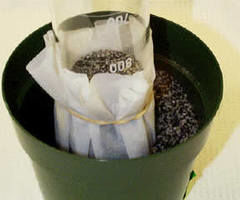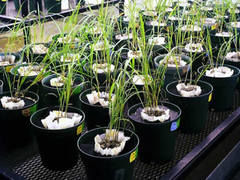Harvesting External Hyphae
Creating Environment
Under carefully set up culture conditions, we take advantage of the natural property of AM fungal hyphae to spontaneously aggregate when in mutual contact. Much of this property is likely due to the same mechanism by which these hyphae facilitate aggregation of soil; the glycoprotein glomalin which pervasively coats hyphal (and many spore) surfaces.
Most of the work, therefore, is in creating the environment for optimal separation of hyphae from the growth medium in which mycorrhizal plants are growing. The method we have used was developed by Sara Wright to measure glomalin production.
Surface-Sterilized

All materials are surface-sterilized in 10% chlorox for 30 minutes, except growth medium, which is steamed at +80oC for two 1-hr periods separated by a 24 hr cooling period.
300-350 cm3 of a growth medium with fungal inoculum is added to a 1000 ml graduated cylinder. Sara uses sand to minimize background levels of glomalin common in soils. We do not have this concern, so we use a sand:soil mix (2:1 v/v). Whole fungal inoculum (essentially chopped pot culture contents, including roots) is mixed in a 1:10 dilution.
A circular piece of 40 µm nylon mesh (from Tetko, Inc.) cut 28-30 cm in diameter is centered over the cylinder and held in place by a heavy rubber band.

The bottom of a 15-cm diameter plastic pot is covered with sterile sand (coarse:fine, 2:1 v/v). We do not seal the holes in the bottom of the pot as pictured (right) The graduated cylinder is inverted and centered in the pot. Additional sterile sand is added to the pot to within 0.5-1 cm of the top of the pot.
Pot Cultures

Sudangrass is seeded into the growth medium filling the nylon mesh “bag” and grown, as all other pot cultures, for 80-90 days. A longer growth period will lead to additional hyphae, but a large proportion of that will be spore-bearing rather than absorptive.
Harvest
At harvest, the nylon mesh bag is gently teased from the pot. The remaining pot contents (sand surrounding the nylon “bag”) are transferred to glass jars, with approx. 300 cubic cm per jar. Sterile distilled water is added to each jar to cover sand by approximately 1 cm and vigorously shaken. Jars are lidded and left to stand at room temperature for several hours.
The contents of the mesh bag also can be treated similarly (after separating roots with a sieve), but presence of soil creates a messier prep.
For for precise manipulations, smaller aliquots of sand from pots can be placed in petri dishes instead of jars.
Within minutes after water is added, AM fungal hyphae begin to aggregate. In the photo at right, hyphae of Gigaspora gigantea is collected. Notice the visible spores trapped in the hyphal aggregates that quickly form.